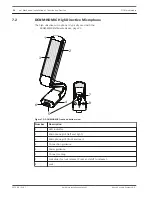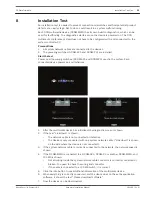
Network and Power connector
Max. power output (W) Max. devices
Socket 1 (12)
No power capacity.
---
Socket 2 (13)
15
1
Socket 3 (15)
144
10
Socket 4 (17)
144
10
Socket 5 (19)
144
10
Table 4.3: Power supply capacity DCNM‑APS / DCNM‑PS
Calculation examples
The following example gives you an indication of the maximum load to each DCNM‑APS or
DCN‑PS socket:
–
Socket 2: 50 m + DCNM‑MMD = 12.50 W
1
–
Socket 3: 10 m + DCNM‑MMD + 9x (2 m + DCNM‑MMD) = 4.50 + 12.50 + (9*1.19) +
(9*12.5) = 140.21 W
2
.
–
Socket 4: 10 m + DCNM‑MMD + 9x (2 m + DCNM‑MMD) = 4.50 + 12.50 + (9*1.19) +
(9*12.5) = 140.21 W
2
.
–
Socket 5: 10 m + DCNM‑MMD + 9x (2 m + DCNM‑MMD) = 4.50 + 12.50 + (9*1.19) +
(9*12.5) = 140.21 W
2
.
1
For socket 2, the cable power consumption of the cable does not need to be counted.
2
The shortest redundant cable does not need to be counted.
Redundant network
If a system network cable between the devices is accidentally disconnected or broken, signals
cannot be transmitted anymore. To prevent this from happening (and to ensure continuous
operation) a redundant system network cable (4) can be connected to a free high‑power
socket (3, 4, or 5).
1
2
3
4
5
Figure 4.4: Example DCNM‑MMD with DCNM‑APS redundant cabling
1.
DCNM‑APS.
2.
DCNM‑MMD.
3.
CAT‑5e cable.
4.
System network cable for redundant cabling.
5.
System network cable for daisy‑chain cabling.
14
en | System installation design and planning
DCN multimedia
2013-08 | V1.0 |
Hardware Installation Manual
Bosch Security Systems B.V.
Summary of Contents for DCN multimedia
Page 1: ...DCN multimedia Conference System en Hardware Installation Manual ...
Page 2: ......
Page 31: ......















































